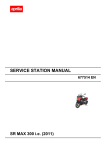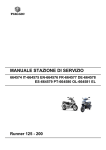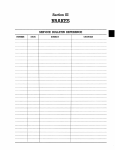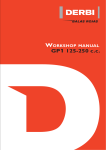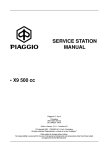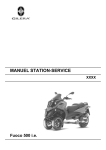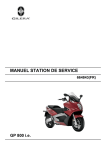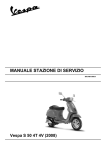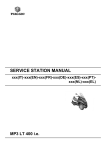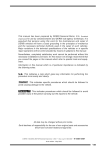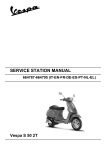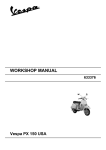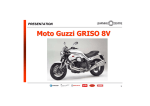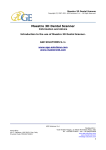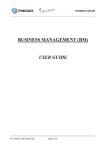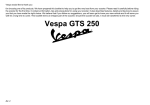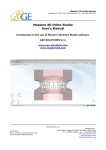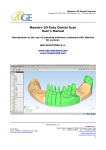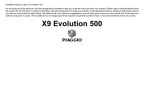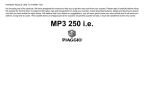Download C - Luzeiro
Transcript
C 4 - STROKE ENGINE 2T 4T PIAGGIO ENGINE MADISON 250 i.e. - Euro 3 WORKSHOP MANUALS C - ENGINE FOUR-STROKE ENGINE Introduction CHAPTER C TABLE OF CONTENTS 08.06 Pr P INTRODUCTION 1 1 4 MANUAL UPDATES 1 1.1 4 NOTES FOR EASY CONSULTATION 1 1.2 5 GENERAL WORK PROCEDURES 1 1.3 8 RECOMMENDATIONS 1 1.4 9 SPARK PLUGS 1 1.5 11 PIAGGIO ENGINE 2 2 13 ENGINE DISASSEMBLY 2 2.0 14 AUTOMATIC TRANSMISSION 2 2.1 14 FINAL REDUCTION 2 2.2 27 FLYWHEEL COVER 2 2.3 32 FLYWHEEL AND STARTING 2 2.4 34 CYLINDER ASSY AND TIMING SYSTEM 2 2.5 37 CRANKCASE - CRANKSHAFT 2 2.6 53 LUBRICATION 2 2.7 61 CRANKSHAFT OIL SEALS 2 2.8 63 OIL PUMP 2 2.9 65 ISSUE ENGLISH S PAGE SECTION 1 3 C - ENGINE C FOUR-STROKE ENGINE CHAPTER 1 Introduction INTRODUCTION • All checks, maintenance, repairs or replacements, etc. on the vehicles manufactured by Malaguti are to be performed by skilled and expert technical personnel with specific experience in state-of-the-art technology and full knowledge of the quickest and most rational procedures, technical characteristics, setting values and tightening torques, which may only be properly and exhaustively provided by the manufacturer. • This set of WORKSHOP MANUALS concerning four-stroke engines provides technicians of the sector (Authorised Service Centres, etc.), the essential information for operating in accordance with the latest good working practices and work safety regulations. • These publications provide all necessary information for routine procedures on all the MALAGUTI motor vehicles equipped with four-stroke engines currently in production at the date of issue. The information provided deals with the motor vehicle ENGINES. Some basic technical information has been intentionally omitted as it is considered to be common knowledge. ENGLISH • Additional information is available in the SPARE PARTS CATALOGUES of each model. • It is important that before referring to the specific engine manual, the information given in this general section be carefully read as it provides all the essential hints and guidelines for best consulting the various topics and main technical subjects. Note: These manuals provide the necessary information and instructions for routine maintenance and servicing. This information has been given to us by the engine manufacturers. We therefore decline all responsibility for any error, omission or misrepresentation. YAMAHA reserves the right to make any changes and modifications hereto it deems necessary without prior notice. For further information and details, please contact the MALAGUTI Service Division. 1.1 MANUAL UPDATES • Updated pages of this publication will be delivered by us (in a reasonable time). The superseded sheets should not be removed from the manual as they remain applicable to the servicing of pre-modified engines. • The table of contents will be duly updated in the event that new pages are inserted, which render the consultation of the manual difficult. • IMPORTANT! The Workshop Manuals are to be considered as essential tools to be properly kept up-to-date so as to maintain their “validity” over time. 4 PAGE SECTION 1 ISSUE 08.06 C - ENGINE FOUR-STROKE ENGINE Introduction CHAPTER C 1.2 NOTES FOR EASY CONSULTATION PAGE LAYOUT Chapter X Engine model W Page n° Z Date of issue X Y ENGLISH Y Z W (RH PAGE) MODIFIED PAGES • Modified pages shall bear the same number as those in the previous edition/pre-modified ones, followed by the letter M, with the date of issue appearing in the appropriate box. • Modified pages may contain new illustrations; in this case, the added illustration (or illustrations) will bear the number of the illustration on the former page, followed by a letter. ADDITIONAL PAGES • Any additional pages shall bear the last number of the section to which they belong, followed by the letter A and the date of issue. EDITING SYMBOLS • Symbols have been provided for quick and easy reference (see page 6), identifying situations requiring utmost attention or providing practical suggestions or simple information. • These symbols may appear next to a text (in which case they refer solely to the text itself), next to a figure (in which case they refer to the topic illustrated in the figure and to the relative text), or at the top of the page (in which case they refer to all the topics dealt with in the page). Note: The meaning of the symbols should be duly memorised as their scope is to avoid having to repeat basic technical concepts or safety recommendations. They are therefore to be considered as veritable “memory tags”. In case of any doubt as to their meaning, consult the page in which they are fully described. 08.06 ISSUE PAGE SECTION 1 5 C - ENGINE FOUR-STROKE ENGINE C CHAPTER Introduction EDITING SYMBOLS A) CAUTION! Recommendations and precautions regarding rider safety and motor vehicle integrity. B) WARNING! Situations entailing the risk of personal injury to maintenance or repair mechanics, other workshop personnel or third parties, or damage to environment, vehicle or equipment. C) B ENGLISH FIRE HAZARD Indicates operations which may constitute a fire hazard. C RISK OF EXPLOSION Indicates operations which may constitute a risk of explosion. D E) TOXIC FUMES Indicates a possibility of intoxication or inflammation of the upper respiratory tract. E F) MECHANICAL MAINTENANCE Operations to be performed only by an expert mechanic. F G) ELECTRICAL MAINTENANCE Operations be performed only by an expert electrical/ electronic technician. G H) NO! Operations to be absolutely avoided. I) ENGINE SERVICE MANUAL Indicates information which may be obtained by referring to said manual. I SPARE PARTS CATALOGUE Indicates information which may be obtained by referring to said catalogue. L D) L) 6 A PAGE SECTION 1 H M R ISSUE 08.06 C - ENGINE FOUR-STROKE ENGINE Introduction CHAPTER C ABBREVIATIONS F Cs P Pr S Sc T V Figure Tightening torque Page Paragraph Section Diagram Table Screw ENGLISH Note: the letter V in the illustrations refers to retaining or adjusting screws. The number following this letter refers to the number of the same type of screw in the unit or component described and illustrated. Letters not followed by a number indicate a single screw. In case of different screws being referred to in the illustration, the letter V is followed by a number and a small letter, for instance: (V4a). Unless otherwise specified, units and components are reassembled by proceeding in the reverse order of removal. OPERATIONAL SYMBOLS L) LOCTITE O) Oil lubrication G) Greasing 08.06 ISSUE L O G PAGE SECTION 1 7 C - ENGINE C FOUR-STROKE ENGINE CHAPTER 1.3 Introduction GENERAL WORK PROCEDURES • The advice, recommendations and warnings given hereafter are aimed at ensuring maximum work safety as well as at considerably reducing the risk of accidents, personal injury, equipment damage and idle times. They should therefore be strictly adhered to. ADVICE: • Only use quality tools and equipment. • Only use equipment conforming to EU Directives for lifting the vehicle. • During operations, always keep tools and equipment at hand, possibly laying them out according to the sequence in which they are to be used. Absolutely avoid putting them on the vehicle itself, out-of-sight or in poorly accessible places. ENGLISH • Always keep the work area clean and tidy. • When tightening screws or nuts, start with the larger diameter or inner fasteners, and tighten them in progressive “pulls” in accordance to a “criss-cross” pattern. • Preferably use open-end box wrenches by “pulling” and not “pushing”. • Adjustable wrenches (F. 1) should only be used in case of emergency, i.e. when a properly sized wrench is not available. They should preferably not be used as the movable jaw tends to open thus risking damaging or not properly tightening the bolt to the correct torque. In any case, when using an adjustable wrench, take care to proceed as shown in Figure 1. • Except for occasional customers, always make out and deliver to the customer a work sheet specifying the operations performed, with notes as to any future checks eventually required. F. 1 8 PAGE SECTION 1 ISSUE 08.06 C - ENGINE FOUR-STROKE ENGINE Introduction 1.4 CHAPTER C WARNINGS • Before carrying out any operation on the vehicle, wait for all parts to cool down. • For operations requiring two mechanics, make sure that the various steps to be performed by each of them are clearly defined and coordinated beforehand. • Make sure that each component has been properly fitted before proceeding with the next one. • Lubricate all parts (where applicable) before reinstalling them. • Gaskets, O-rings, circlips and split pins must be replaced at every refitting. • The torque settings specified in the manuals refer to the “final torque”, which must be attained progressively by steps. ENGLISH • Loosen and tighten aluminium alloy parts (covers) only after the engine has fully cooled down. • Only use screwdrivers with sizes suitable to the screws to be loosened or tightened. • Work in a comfortable position and ensure that the vehicle is stable. • Never use a screwdriver as a lever or chisel. • Never use pincers to loosen or tighten screws or nuts because, in addition to not providing a sufficient clamping force, they may also damage the screw head or nut hexagon. • Never tap the wrench with a hammer or other similar tools to loosen or tighten screws and nuts (F. 2). • Never attempt to increase the lever arm by fitting a tube into the wrench (F. 3). F. 2 08.06 ISSUE F. 3 PAGE SECTION 1 9 C - ENGINE C FOUR-STROKE ENGINE Introduction CHAPTER Never use open flames for any reason. Never leave open containers or containers not suitable for holding fuel in passageways, close to heat sources, etc Never use petrol to clean the vehicle or the floor of the workshop. Always use low flash point solvents to clean the vehicle components. Never suck from or blow into the fuel pipe. When welding, make sure that there are no flammable liquids in the vicinity. Always remove the tank, even if completely empty, and disconnect the negative cable (-) from the battery. Never leave the engine running in closed or poorly ventilated areas. ENGLISH Before any servicing, make sure that the motorbike is perfectly stable. The front wheel should preferably be anchored to the equipment (A - F 4) integral with the lifting board. A F. 4 10 PAGE SECTION 1 ISSUE 08.06 C - ENGINE FOUR-STROKE ENGINE Introduction CHAPTER C 1.5 SPARK PLUGS 1 Insulator 2 Body 3 Gasket 4 5 6 Electrode Earth electrode Threads ENGLISH F. 5 SPARK PLUG MAINTENANCE • Spark plug maintenance consists essentially of a periodical visual inspection. Remove the spark plug and check for proper condition and gap. • Clean the electrodes and the insulator thoroughly by means of a wire brush. • Remove any residual dirt with a strong jet of compressed air. • Lubricate spark plug thread with engine oil or graphitised grease, and install it by hand until finger tight. Tighten to the specified torque with a spark plug wrench (see F.6). It is imperative that any spark plug exhibiting cracks on the insulator or corroded electrodes be replaced. SPARK PLUG REPLACEMENT 20,000 km • Upon prescribed mileage being reached, always replace the spark plug. Use YAMAHA recommended spark plugs. • When replacing exhausted spark plugs, visually inspect spark plug condition as described above to ascertain whether or not the engine is running properly. 08.06 ISSUE PAGE SECTION 1 11 CHAPTER SECTION 2 Piaggio Engine WORKSHOP MANUALS ISSUE 08.06 C C - ENGINE FOUR-STROKE ENGINE C CHAPTER Piaggio Engine 2.0 ENGINE DISASSEMBLY See Chapter A of “Chassis” manual 2.1 AUTOMATIC TRANSMISSION Transmission cover - To remove the transmission cover it is necessary to remove the plastic cover first, by inserting a screwdriver in the slotted holes. Using the clutch bell lock wrench shown in the figure, remove the driven pulley axle locking nut and washer. Specific tooling 020423Y driven pulley stop wrench ENGLISH - Remove the cap/dipstick from the engine oil filling hole. Remove the ten screws. Remove the transmission cover. N.B. WHEN YOU ARE REMOVING THE TRANSMISSION COVER YOU MUST BE CAREFUL NOT TO DROP THE CLUTCH BELL. Air duct 14 - Remove the transmission compartment air intake cover shown in the photograph. - Remove the five screws on two different levels as well as the small casing. PAGE ISSUE SECTION 2 08.06 C - ENGINE FOUR-STROKE ENGINE Piaggio Engine CHAPTER C PAGE 15 Removing the driven pulley shaft bearing - Remove the clip from the inside of the cover. Remove the bearing from the crankcase by means of: Specific tooling 020376Y Handle for adaptors 020375Y Adapter 28 x 30 mm 020412Y 15 mm guide Refitting the driven pulley shaft bearing - Slightly heat the crankcase from the inside so as not to damage the painted surface. Insert the bearing in its seat. Refit the seeger ring. ENGLISH - CAUTION USE AN APPROPRIATE REST SURFACE TO AVOID DAMAGING THE COVER PAINT. N.B. ALWAYS REPLACE THE BEARING WITH A NEW ONE UPON REASSEMBLY. Specific tooling 020376Y Handle for adaptors 020357Y 32 x 35 mm adaptor 020412Y 15 mm guide 08.06 ISSUE SECTION 2 SECTION 3 C - ENGINE FOUR-STROKE ENGINE C CHAPTER Piaggio Engine Baffle roller - - Check that the roller does not show signs of wear and that it turns freely. Remove the special clamping screws as indicated in the photograph Check the outer diameter of the roller does not have defects that could jeopardise belt functioning For refitting, place the roller with the belt containment edge on the engine crankcase side Tighten the screw at the specified torque. ENGLISH Locking torques (N*m) Anti-flapping roller 12 ÷ 16 Removing the driven pulley - Remove the clutch bell housing and the driven pulley assembly. N.B. THE UNIT CAN BE REMOVED EVEN WITH THE DRIVING PULLEY FITTED. Inspecting the clutch drum - Check that the clutch bell is not worn or damaged. Measure the clutch bell inside diameter. Characteristic Max value clutch bell Max value: Ø 134.5 mm Clutch Bell Standard value Standard value: Ø134 ÷ 134.2 mm 16 PAGE ISSUE SECTION 2 08.06 C - ENGINE FOUR-STROKE ENGINE Piaggio Engine CHAPTER C PAGE 17 Checking the bell working surface eccentricity - - Install the bell on a driven pulley shaft using 2 bearings (inner diameter 15 and 17 mm). Lock using the original spacer and nut. Place the bell/shaft assembly on the support to check the crankshaft alignment. Using a feeler pin gauge and the magnetic base, measure the bell eccentricity. Repeat the measurement in 3 positions (central, internal, external). In case of anomalies, replace the bell. ENGLISH - Specific tooling 020074Y Support base for checking crankshaft alignment 020335Y Magnetic stand for dial gauge Specifications Check clutch housing Eccentricity threshold Max. permissible eccentricity: 0,15 mm Removing the clutch Fit the special driven pulley spring compressor tool with medium length pins in position “C” screwed up from the inner side of the tool. - Introduce adapter ring n° 11 with the chamfering facing the inside of the tool. - Fit the driven pulley assembly on the tool with the insertion of the three pins in the ventilation holes in the earth holder support. - Make sure that the clutch is perfectly inserted into the adapter ring before proceeding to loosen/tighten the clutch nut. - Use the special 46x55 wrench component n°9 to remove the nut fixing the clutch in place. - Dismantle the driven pulley components (Clutch and spring with its plastic holder) CAUTION THE TOOL MUST BE FIRMLY FIXED IN THE CLAMP AND THE CENTRAL SCREW MUST BE BROUGHT INTO CONTACT WITH THE TOOL. EXCESSIVE TORQUE CAN CAUSE THE APPROPRIATE TOOL TO BUCKLE. Specific tooling 020444Y011 Adapter ring 020444Y009 wrench 46 x 55 020444Y Driven pulley spring compressor fit/removal tool 08.06 ISSUE SECTION 2 SECTION 3 C - ENGINE FOUR-STROKE ENGINE C CHAPTER Piaggio Engine Inspecting the clutch - Check the thickness of the clutch mass friction material. The masses must not show traces of lubricants; otherwise, check the driven pulley unit seals. N.B. UPON RUNNING-IN, THE MASSES MUST EXHIBIT A CENTRAL CONTACT SURFACE AND MUST NOT BE DIFFERENT FROM ONE ANOTHER. DIFFERENT CONDITIONS MAY CAUSE CLUTCH TEARING. CAUTION DO NOT OPEN THE MASSES USING TOOLS TO PREVENT A VARIATION IN THE RETURN SPRING LOAD. ENGLISH Characteristic Check minimum thickness 1 mm Pin retaining collar - Simultaneously turn and pull the collar manually to remove it. N.B. USE TWO SCREWDRIVERS IF YOU HAVE DIFFICULTY. N.B. BE CAREFUL NOT TO PUSH THE SCREW DRIVERS IN TOO FAR TO AVOID DAMAGE THAT COULD ENDANGER THE ORING SEAL. - 18 Remove the four torque server pins and pull the half pulleys apart. PAGE ISSUE SECTION 2 08.06 C - ENGINE FOUR-STROKE ENGINE Piaggio Engine CHAPTER C PAGE 19 Removing the driven half-pulley bearing - - Check there are no signs of wear and/or noisiness; Replace with a new one if there are. Remove the retaining ring using two flat blade screwdrivers. Support the pulley bushing adequately from the threaded side using a wooden surface. Using a hammer and pin, knock the ball bearing out as shown in the figure. Support the pulley properly using the bell as shown in the figure. ENGLISH - Specific tooling 001467Y035 Bearing housing external ø 47 mm - Remove the roller bearing using the modular punch. Specific tooling 020376Y Handle for adaptors 020456Y Ø 24 mm adaptor 020363Y 20mm guide Inspecting the driven fixed half-pulley - Version 250 Measure the outer diameter of the pulley bushing. Check the contact surface with the belt to make sure there are no flaws. Check the riveted joints are functional. Check the evenness of the belt contact surface. Characteristic Minimum half pulley diameter Minimum admissible diameter Ø 40.96 mm Standard half pulley diameter Standard diameter Ø 40.985 mm wear limit: 0.3 mm 08.06 ISSUE SECTION 2 SECTION 3 C - ENGINE FOUR-STROKE ENGINE C CHAPTER Piaggio Engine Inspecting the driven sliding half-pulley - Remove the two internal grommets and the two O-rings. Measure the inner diameter of the mobile half-pulley’s central bushing. Check the contact surface with the belt to make sure there are no flaws. Check the riveted joints are functional. Check the evenness of the belt contact surface. MOBILE DRIVEN HALF PULLEY DIMENSIONS ENGLISH Specification wear limit standard diameter maximum allowable diameter Desc./Quantity 0.3 mm Ø 41,000 ÷ 41,035 mm Ø 41.08 mm Refitting the driven half-pulley bearing - Support the pulley bushing adequately from the threaded side using a wooden surface. Fit a new roller sleeve as in the figure. For the fitting of the new ball bearing, follow the example in the picture using a modular punch. Fit the retention ring N.B. Fit the ball bearing with the visible shield Specific tooling 020376Y Handle for adaptors 020375Y Adapter 28 x 30 mm 020424Y Driven pulley roller casing fitting punch 20 PAGE ISSUE SECTION 2 08.06 C - ENGINE FOUR-STROKE ENGINE Piaggio Engine CHAPTER C PAGE 21 Refitting the driven pulley - Insert the new oil guards and O-rings on the mobile half-pulley. Lightly grease the O-rings O-R (A) shown in the figure. Fit the half-pulley over the bushing using the appropriate tool Check that the pins are not worn and proceed with the refitting in the relative hollows.Refit the torque server closure collar. Using a curved-spout grease gun, lubricate the driven pulley assembly with approximately 6 gr of grease. Apply the grease through one of the holes in the bushing until it comes out through the hole on the opposite side. This operation is necessary to avoid the presence of grease beyond the Orings. ENGLISH N.B. THE TORQUE SERVER GREASING OPERATION CAN BE DONE BOTH WITH BEARINGS FITTED AND WHEN THEY ARE BEING REPLACED; UNDERTAKING THE OPERATION WHEN THE BEARINGS ARE BEING SERVICED MIGHT BE EASIER. Specific tooling 020263Y Driven pulley assembly sheath Recommended products TUTELA MRM 2 Grease for the rotating ring of the tone wheel Molybdenum disulphide grease and lithium soap Inspecting the clutch spring - Measure the length of the spring, while it is relaxed. Characteristic Standard length: 123 mm Acceptable limit after use: 118 mm 08.06 ISSUE SECTION 2 SECTION 3 C - ENGINE FOUR-STROKE ENGINE C CHAPTER Piaggio Engine Refitting the clutch - ENGLISH - - Support the driven pulley spring compressor appropriate tool with the control screw in vertical axis. Arrange the tool with the medium length pins screwed in position «C» on the inside. Introduce the adapter ring n° 11 with the chamfering facing upwards. Insert the clutch on the adapter ring. Lubricate the end of the spring that abuts against the servosystem closing collar. Insert the spring with relevant plastic holder in contact with the clutch. Insert the driving belt into the pulley unit according to their direction of rotation. Insert the pulley unit with the belt into the tool. Slightly pre-load the spring. Make sure that the clutch is perfectly inserted into the adapter ring before proceeding to tighten the clutch nut. Place the tool in the clamp with the control screw on the horizontal axis. Fully pre-load the spring. Apply the clutch fixing nut and tighten it to the specified torque using the special 46x55 wrench. Loosen the tool clamp and insert the belt according to its direction of rotation. Lock the driven pulley again using the appropriate tool. Pre-load the clutch return spring by turning and pulling at the same time and place the belt in the smaller diameter rolling position. Remove the driven pulley /belt assembly from the tool. N.B. DURING THE SPRING PRE-LOADING PHASE, BE CAREFUL NOT TO DAMAGE THE PLASTIC SPRING STOP AND THE BUSHING THREADING. N.B. FOR DESIGN REASONS, THE NUT IS SLIGHTLY ASYMMETRIC; THE FLATTEST SURFACE SHOULD BE MOUNTED IN CONTACT WITH THE CLUTCH. Specific tooling 020444Y Driven pulley spring compressor fit/removal tool 020444Y011 Adapter ring 020444Y009 wrench 46 x 55 Locking torques (N*m) Clutch assembly nut on driven pulley 45 ÷ 50 22 PAGE ISSUE SECTION 2 08.06 C - ENGINE FOUR-STROKE ENGINE Piaggio Engine CHAPTER C PAGE 23 Refitting the driven pulley - Refit the clutch bell. Drive-belt Check that the driving belt is not damaged. Check the width of the belt. ENGLISH - Characteristic 250 4T Transmission belt/Minimum width: 19.5 mm 250 4T Transmission belt/standard width: 21.3 ± 0.2 mm During the wear checks in the scheduled servicing programme, you are advised to check the rim bottom of the toothing does not show signs of incisions or cracking (see figure). 08.06 ISSUE SECTION 2 SECTION 3 C - ENGINE FOUR-STROKE ENGINE C CHAPTER Piaggio Engine Removing the driving pulley Turn the crankshaft until the ropes of the pulley are on a horizontal axis - Insert the adaptor sleeve of the appropriate tool in the hole shown in the photograph - Insert the tool in the hollows and apply the retention ring Bring in the ring’s clamping screws while keeping the tool to support the pulley ENGLISH - Specific tooling 020626Y Driving pulley stop wrench - 24 Remove the fixing nut and the washer Remove the stationary half driving pulley. PAGE ISSUE SECTION 2 08.06 C - ENGINE FOUR-STROKE ENGINE Piaggio Engine CHAPTER C PAGE 25 Inspecting the rollers case - - Check that the internal bushing shown in the figure is not abnormally worn and measure inner diameter A. Measure outer diameter B of the pulley sliding bushing shown in the figure. Check that the rollers are not damaged or worn. Check the guide shoes for the variator back-plate are not worn. Check there is no wear in the roller housing, and the surfaces in contact with the belt on either of the half-pulleys. Check that stationary driving pulley does not show signs of abnormal wear on the grooved edge and on the surface in contact with the belt. Check that the O-ring is not pushed out of shape. ENGLISH CAUTION DO NOT LUBRICATE OR CLEAN SINTERED BUSHINGS Characteristic Mobile driving half pulley bushing / Standard diameter 26,000 ÷ 26,021 mm Mobile driving half pulley bushing / Maximum allowable diameter Ø 26.12 mm Sliding bushing / Standard Diameter Ø 25.959 ÷ 25.98 mm Sliding bushing: Minimum admissible diameter Ø 25.95 mm Roller: Standard Diameter Ø 20.5 ÷ 20.7 mm Roller: Minimum admissible diameter Ø 20 mm 08.06 ISSUE SECTION 2 SECTION 3 C - ENGINE FOUR-STROKE ENGINE C Piaggio Engine CHAPTER Refitting the driving pulley ENGLISH - Pre-assemble the mobile half pulley with the roller contrast plate by putting the rollers in their housings with the larger support surface touching the pulley according to the direction of rotation. - Check that the roller contact plate does not have flaws and is not damaged on the grooved edge. Mount the complete bushing unit on the driving shaft. Fit the driven pulley/Clutch/belt assembly on the engine - - Fit the steel shim in contact with the bushing and the stationary driving pulley. Install the appropriate tool as described in the removal phase. Tighten the nut with washer to the specified torque. Specific tooling 020626Y Driving pulley stop wrench Locking torques (N*m) Driving pulley nut 75 ÷ 83 Refitting the transmission cover - - Check the presence of the 2 centring dowels and the correct installation of the sealing gasket for the oil sump on the transmission cover. Replace the cover tightening the 10 screws at the specified torque. Replace the oil loading cap/bar. Replace the steel washer and the driven pulley nut. Tighten the nut at the specified torque using the lock wrench and the torque wrench tools. Replace the plastic cover. Specific tooling 020423Y driven pulley stop wrench Locking torques (N*m) Transmission cover screws 11 ÷ 13 Driven pulley axle nut 54 ÷ 60 26 PAGE ISSUE SECTION 2 08.06 C - ENGINE FOUR-STROKE ENGINE Piaggio Engine CHAPTER C PAGE 27 2.2 END GEAR Removing the hub cover - Empty the rear hub through the oil drainage tap. Remove the 7 flanged screws indicated in the figure. Remove the hub cover and its gasket. - ENGLISH Removing the wheel axle Remove the wheel axis complete with gear. Remove the intermediate gear. Removing the hub bearings - - Check the state of the bearings being examined (wear, clearance and noisiness). If faults are detected, do the following. Use the bearing extractor, available as an appropriate tool, to remove the three 15 mm bearings (two in the crankcase and one in the hub cover). Specific tooling 001467Y013 Extraction pliers for ø 15 mm bearings 08.06 ISSUE SECTION 2 SECTION 3 C - ENGINE FOUR-STROKE ENGINE C CHAPTER Piaggio Engine Removing the wheel axle bearings - Take out the clip on the outside of the gearbox cover. Support the hub cover and expel the bearing. By means of the appropriate tools, remove the oil guard as in the figure. Specific tooling 020376Y Handle for adaptors 020477Y 37 mm adapter 020483Y 30 mm guide 020359Y 42 x 47 mm adaptor 020489Y Hub cover support stud bolt set ENGLISH Removing the driven pulley shaft bearing - - - As you need to remove the driven pulley shaft, its bearing and oil guard, remove the transmission cover as described above. Extract the driven pulley shaft from its bearing. Remove the oil guard using a screwdriver, working from inside the bearing and being careful not to damage the housing, make it come out of the belt transmission side. Remove the seeger ring shown in the figure Remove the driven pulley shaft bearing using the modular punch. Specific tooling 020376Y Handle for adaptors 020375Y Adapter 28 x 30 mm 020363Y 20mm guide 28 PAGE ISSUE SECTION 2 08.06 C - ENGINE FOUR-STROKE ENGINE Piaggio Engine CHAPTER C PAGE 29 Inspecting the hub shaft - - Check that the three shafts exhibit no wear or deformation on the toothed surfaces, at the bearing connections and at the oil guards. In case of anomalies, replace the damaged components. Inspecting the hub cover Check that the fitting surface is not dented or distorted. Check the bearing bearings. In case of anomalies, replace the damaged components ENGLISH - Refitting the wheel axle bearing - Support the hub cover on a wooden surface. Heat the cover crankcase with special heat gun. Fit the wheel axle bearing with a modular punch as shown in the figure. - Fit the seeger ring. - Fit the oil guard with seal lip towards the inside of the hub and place it flush with the internal surface by means of the appropriate tool used from the 52 mm side. The 52 mm side of the adapter must be turned towards the bearing. Specific tooling 020376Y Handle for adaptors 020360Y 52 x 55 mm adaptor 020483Y 30 mm guide 08.06 ISSUE SECTION 2 SECTION 3 C - ENGINE FOUR-STROKE ENGINE C Piaggio Engine CHAPTER Refitting the hub cover bearings For the fitting of the hub box bearings the engine crankcase and the cover must be heated with the special heat gun. - The three 15 mm bearings must be fitted using the appropriate tools. The 42 mm side of the adapter must be turned towards the bearing. Specific tooling 020150Y Air heater support 020151Y Air heater 020376Y Handle for adaptors 020359Y 42 x 47 mm adaptor 020412Y 15 mm guide ENGLISH N.B. Use the stud bolt set in the fitting of the bearing on the cover to support said cover. Refit the driven pulley axle bearing with a modular punch as shown in the figure. N.B. If the bearing has an asymmetrical ball retention cage, place it with the balls visible from the inside side of the hub. Specific tooling 020376Y Handle for adaptors 020359Y 42 x 47 mm adaptor 020363Y 20mm guide N.B. When fitting the bearings on the engine crankcase, this should, as far as possible, be supported on a surface to allow the bearings to be driven vertically. - 30 Refit the seeger ring with the opening facing the bearing and fit a new oil guard flush with the crankcase from the pulley side. PAGE ISSUE SECTION 2 08.06 C - ENGINE FOUR-STROKE ENGINE Piaggio Engine CHAPTER C PAGE 31 Refitting the hub bearings - Install the three shafts in the engine crankcase as shown in the figure. Refitting the ub cover - - Fit a new gasket together with the centring dowels. Seal the gasket of the breather pipe using black silicone sealant. Fit the gearbox cover, making sure the breather tube is in the correct position. Position the shorter screw that can also be recognised from the different colour as shown in the figure. Fix the breather tube support by means of the lower screw. ENGLISH - Fit the remaining screws and tighten the seven screws to the specified torque. 08.06 ISSUE SECTION 2 SECTION 3 C - ENGINE FOUR-STROKE ENGINE C CHAPTER Piaggio Engine 2.3 FLYWHEEL COVER Removing the hub cover ENGLISH - Remove the clip fixing the hose to the cylinder. - Remove the ten fixings Remove the flywheel cover. Removing the stator - - Remove the two Pick-Up screws and the screw holding the wiring support and the three stator clamping screws shown in the figure. Remove the stator and its wiring. Refitting the stator - Refit the stator and flywheel carrying out the removal procedure in reverse, tightening the studs to the specified torque. Locking torques (N*m) Stator assembly screws (°) 3 ÷ 4 32 PAGE ISSUE SECTION 2 08.06 C - ENGINE FOUR-STROKE ENGINE Piaggio Engine CHAPTER C PAGE 33 - Position the spline clip on the crankshaft and orient the end as shown in the figure. - Orient the water pump shaft with reference to the transmission gear seat as shown in the photo. Refit the cover over the engine and tighten the screws to the specified torque. Carry out the steps in the reverse order from the dismantling procedure. - ENGLISH Refitting the flywheel cover CAUTION TAKE CARE TO CORRECTLY POSITION THE FLYWHEEL CONNECTOR. MAKE SURE THE CENTRING DOWELS ARE PRESENT. Locking torques (N*m) Flywheel cover screws 11 - 13 08.06 ISSUE SECTION 2 SECTION 3 C - ENGINE FOUR-STROKE ENGINE C Piaggio Engine CHAPTER 2.4 FLYWHEEL AND STARTING Removing the starter motor - Remove the two screws indicated in the figure. Take the starter motor out of its seat Removing the flywheel magneto Remove the water pump shaft and crankshaft spline clip - Line up the two holes in the flywheel as shown in the photo - Screw in the guide bushing that is part of the special flywheel stop tool on the flywheel as shown in the photo ENGLISH - - I nsert the special flywheel stop tool on the flywheel as shown in the photo Specific tooling 020627Y Flywheel stop wrench 34 PAGE ISSUE SECTION 2 08.06 C - ENGINE FOUR-STROKE ENGINE - Remove the plate indicated in the photo. - Remove the flywheel nut with its washer Do up the flywheel nut by three or four threads so that the flywheel does not fall accidentally on extraction Screw the extractor onto the flywheel and extract it as shown in the photograph - CHAPTER C PAGE 35 ENGLISH Piaggio Engine Specific tooling 020467Y Flywheel extractor Inspecting the flywheel components - Check the integrity of the internal plastic parts of the flywheel and the pick-up control plate. Refitting the free wheel - Make sure the free wheel contact surfaces are in good condition. Thoroughly clean the free wheel to remove LOCTITE residue. Degrease the threading of the holes in the free wheel and the clamping screws. Apply the recommended product to the end of the screws. Recommended products Loctite 243 Medium threadlock - - Fit the free wheel on the magneto flywheel making sure that the ground side is in contact with the flywheel itself, i.e. with wheel’s seeger ring visible. Lock the six clamping screws in criss-cross fashion to the specified torque. Locking torques (N*m) Screw for fixing free wheel to the flywheel 13 - 15 - Oil the free wheel “rollers”. 08.06 ISSUE SECTION 2 SECTION 3 C - ENGINE FOUR-STROKE ENGINE C CHAPTER Piaggio Engine Refitting the flywheel magneto - - Insert the free wheel on the flywheel as shown in the photo Then refit the flywheel with free wheel and transmission gear - Using the special flywheel stop tool, tighten up the flywheel fixing nut to the specified torque Refit the retention plate ENGLISH - Remove the free wheel retaining plate indicated in the photograph Remove the transmission gear and the free wheel - Specific tooling 020627Y Flywheel stop wrench Locking torques (N*m) flywheel nut 94 ÷ 102 Refitting the starter motor - Fit a new O-ring on the starter motor and lubricate it. Fit the starter on the crankcase, locking the two screws to the specified torque. Locking torques (N*m) Starter screws 11 to 13 36 PAGE ISSUE SECTION 2 08.06 C - ENGINE FOUR-STROKE ENGINE Piaggio Engine CHAPTER C PAGE 37 2.5 CYLINDER ASSY. AND TIMING SYSTEM Removing the intake manifold - Loosen the three screws and remove the air intake manifold. When refitting, secure to the specified torque. Removing the rocker-arms cover Remove the 5 screws indicated in the figure. ENGLISH - Removing the timing system drive - - Remove the parts listed below first: transmission cover, driving pulley with belt, oil sump with spring and by-pass piston, oil pump pulley cover, O-ring on the crankshaft and the sprocket wheel separation washer. Remove the tappet cover. Remove the central screw fastener and the automatic valvelifter retaining cover, as shown in the figure. - Remove the return spring of the automatic valve lifter assembly and the automatic valve lifter assembly and its end of stroke washer. - Loosen the central screw on the tensioner first. Remove the two fixings shown in the figure. Remove the tensioner with its gasket. 08.06 ISSUE SECTION 2 SECTION 3 C - ENGINE FOUR-STROKE ENGINE C CHAPTER Piaggio Engine Remove the internal hex screw and the counterweight shown in the figure. - Remove the camshaft command pulley and its washer. - Remove the command sprocket wheel and the timing chain. Remove the screws indicated in the figure, the spacer bar and the tensioner pad. The chain tensioning pad must be removed from the transmission side. As regards the lower chain guide pad, it may only be removed after the head has been removed. ENGLISH - N.B. IT IS ADVISABLE TO MARK THE CHAIN IN ORDER TO ENSURE THAT THE INITIAL DIRECTION OF ROTATION IS MAINTAINED. 38 PAGE ISSUE SECTION 2 08.06 C - ENGINE FOUR-STROKE ENGINE Piaggio Engine CHAPTER C PAGE 39 Removing the cam shaft - Remove the two screws and the cam shaft retainer shown in the diagram. Remove the cam shaft. Remove the pins and the rocker arms from the flywheel side holes. ENGLISH N.B. IN CASE OF NEED, THE HEAD MAY BE REMOVED WITH THE CAMSHAFT, PINS, ROCKERS AND FIXING BRACKET. THE HEAD CAN ALSO BE REMOVED WITHOUT REMOVING THE CHAIN AND THE DRIVING SHAFT CHAIN TIGHTENER. Removing the cylinder head - Remove the spark plug. Remove the 2 side fixings shown in the figure. Loosen the 4 head-cylinder fastening nuts in two or three stages and in criss-cross fashion. Remove the head, the two centring dowels and the gasket. 08.06 ISSUE SECTION 2 SECTION 3 C - ENGINE FOUR-STROKE ENGINE C CHAPTER Piaggio Engine Removing the valves - Using the appropriate tool fitted with an adapter, remove the cotter pins, plates, springs and valves. Remove the oil guards with the appropriate tool. Remove the lower spring supports. CAUTION Replace the valves in such a way as to recognise their original position on the head. Specific tooling 020382Y011 adapter for valve removal tool 020382Y Tool for removing valve cotters equipped with part 012 020431Y Valve oil guard extractor ENGLISH Removing the cylinder - piston assy. - Remove the chain guide pad. Remove the 4 O-Rings on the stud bolts. Pull out the cylinder. Remove the cylinder base gasket. Remove the two stop rings, the wrist pin and the piston. Remove the piston seals. CAUTION TO AVOID DAMAGING THE PISTON, SUPPORT IT WHILE REMOVING THE CYLINDER. N.B. BE CAREFUL NOT TO DAMAGE THE SEALING RINGS DURING REMOVAL. 40 PAGE ISSUE SECTION 2 08.06 C - ENGINE FOUR-STROKE ENGINE Piaggio Engine CHAPTER C PAGE 41 Inspecting the small end - Measure the internal diameter of the small end using an internal micrometer. N.B. If the diameter of the rod small end exceeds the standard diameter, shows signs of wear or overheating, replace the crankshaft. ENGLISH Characteristic Checking the connecting rod small end: Maximum diameter 15.030 mm Checking the connecting rod small end: Standard diameter 15,015 - 15,025 mm Inspecting the wrist pin - Measure the outer diameter of the gudgeon pin. Calculate the rod small end - gudgeon pin coupling clearance. Characteristic Pin diameter: Standard clearance 0.015 ÷ 0.029 mm Pin diameter Standard diameter 14.996 ÷ 15.000 mm 08.06 ISSUE SECTION 2 SECTION 3 C - ENGINE FOUR-STROKE ENGINE C CHAPTER Piaggio Engine Inspecting the piston - Measure the diameter of the wrist pin seat on the piston. Calculate the piston pin coupling clearance. Measure the outside diameter of the piston, perpendicular to the gudgeon pin axis. Take the measurement at 5 mm from the base in the position shown in the figure. Carefully clean the seal housings. Measure the coupling clearance between the seal rings and the grooves using suitable sensors, as shown in the diagram. If the clearances exceed the limits specified in the table below, the piston should be replaced by a new one. N.B. MEASURE THE CLEARANCE BY INSERTING THE BLADE OF THE FEELER GAUGE FROM THE SECOND SEAL SIDE. ENGLISH N.B. THE PIN HOUSINGS HAVE TWO LUBRICATION CHANNELS. FOR THIS REASON MEASUREMENT OF THE DIAMETER MUST BE CARRIED OUT ACCORDING TO THE AXIS OF THE PISTON. Characteristic Wrist pin seat on the piston: Standard diameter 15.001 ÷ 15.006 mm Diameter of the wrist pin seat on the piston: Standard clearance 0.001 ÷ 0.010 mm Fitting clearance Middle piston ring standard coupling clearance 0.015 ÷ 0.06 mm Middle piston ring maximum clearance allowed after use 0.07 mm scraper ring standard coupling clearance 0.015 ÷ 0.06 mm scraper ring maximum clearance allowed after use 0.07 mm Inspecting the cylinder - - Using a bore meter, measure the inner cylinder diameter at three different points according to the directions shown in the figure. Check that the head coupling surface is not worn or misshapen. Pistons and cylinders are classified according to diameter. The coupling must be made with those of the same type (MM, N-N, O-O, P-P). Characteristic Cylinder: standard diameter: 71.990 ÷ 72.018 mm (at 33 mm) Maximum allowable runout: 0.05 mm 42 PAGE ISSUE SECTION 2 08.06 C - ENGINE FOUR-STROKE ENGINE Piaggio Engine CHAPTER C PAGE 43 Inspecting the piston rings - - Alternately insert the three sealing rings into the cylinder, in the area where it retains its original diameter. Using the piston, insert the rings perpendicularly to the cylinder axis. Measure the opening (see figure) of the sealing rings using a feeler gauge. If any measurements are greater than specified, replace the piston rings. ENGLISH N.B. BEFORE REPLACING ONLY THE PISTON RINGS, ENSURE THAT THE CLEARANCE BETWEEN THE PISTON RINGS AND THE PISTON RING GROOVES, AND BETWEEN THE PISTON AND THE CYLINDER, IS AS SPECIFIED. IN ANY CASE, NEW PISTON RINGS USED IN COMBINATION WITH A USED CYLINDER MAY HAVE DIFFERENT BEDDING CONDITIONS THAN THE STANDARD. Characteristic Top piston ring Standard opening: 0.15 ÷ 0.30 mm Middle piston ring Standard opening: 0.20 ÷ 0.40 mm scraper ring Standard opening: 0.20 ÷ 0.40 mm Removing the piston - Install piston and wrist pin onto the connecting rod, aligning the piston arrow the arrow facing towards the exhaust. - Fit the wrist pin stop ring onto the appropriate tool - With opening in the position indicated on the tool S = left D = right - S D Place the wrist pin stop ring into position using a punch Fit the wrist pin stop using the plug as shown in the figure N.B. THE TOOL FOR INSTALLING THE STOP RINGS MUST BE USED MANUALLY. CAUTION USING A HAMMER MIGHT DAMAGE THE STOPS’ HOUSING. Specific tooling 020454Y Tool for fitting piston pin stops (200 - 250) 08.06 ISSUE SECTION 2 SECTION 3 C - ENGINE FOUR-STROKE ENGINE C CHAPTER Piaggio Engine Choosing the gasket Characteristic Compression ratio 250 version CR: 10.5 ÷ 11.5 : 1 N.B. MEASUREMENT “A” TO BE TAKEN IS A VALUE OF PISTON RE-ENTRY, IT INDICATES BY HOW MUCH THE PLANE FORMED BY THE PISTON CROWN FALLS BELOW THE PLANE FORMED BY THE TOP OF THE CYLINDER. THE FURTHER THE PISTON FALLS INSIDE THE CYLINDER, THE LESS THE BASE GASKET IS TO BE APPLIED (TO RECOVER THE COMPRESSION RATIO) AND VICEVERSA. ENGINE 250 SHIMMING Name shimming shimming shimming Measure A 3.70 - 3.60 3.60 - 3.40 3.40 - 3.30 Thickness 0.4 ± 0.05 0.6 ± 0.05 0.8 ± 0.05 ENGLISH Refitting the piston rings - - - Place the oil scraper spring on the piston. Re-fit the oil scraper ring with the join of spring ends on the opposite side from the ring gap and the word ‘TOP’ towards the crown of the piston. The chamfered side of the oil scraper ring should always be facing the piston crown. Fit the middle piston ring with the identification letter facing the crown of the piston. The tapered side of the middle piston ring should always be facing away from the crown of the piston. Fit the top piston ring with the word ‘TOP’ or the reference mark facing the crown of the piston. Offset the piston ring gaps on the three rings by 120° to each other as shown in the figure. Lubricate the components with engine oil. The top piston ring on the 250 engine has an L cross section. N.B. THE TWO PISTON RINGS ARE MADE WITH A TAPERED CYLINDRICAL CONTACT CROSS-SECTION. THIS IS TO ACHIEVE A BETTER BEDDING. 44 PAGE ISSUE SECTION 2 08.06 C - ENGINE FOUR-STROKE ENGINE Piaggio Engine CHAPTER C PAGE 45 Refitting the cylinder - Fit the base gasket of the chosen thickness, previously determined. Using the fork support and the piston ring retaining band, refit the cylinder as shown in the figure. N.B. BEFORE FITTING THE CYLINDER, CAREFULLY BLOW OUT THE LUBRICATION DUCT AND OIL THE CYLINDER BARREL. Specific tooling 020426Y Piston fitting fork 020393Y Piston assembly band - - ENGLISH Inspecting the cylinder head Using a trued bar and feeler gauge check that the cylinder head surface is not worn or distorted. Maximum allowable runout: 0,05 mm Ensure that the camshaft and rocker arm pivot bearings show no signs of wear. Check that the cylinder head cover surface, the intake manifold and the exhaust manifold are not worn. Specifications Capacity “A”: Ø 12.000 ÷ 12.018 Capacity “B”: Ø 20.000 ÷ 20.021 Capacity “C”: Ø 37.000 ÷ 37.025 Inspecting the timing system components - - Check that the guide shoe and the tensioner shoe are not worn out. Ensure that the camshaft drive pulley, the chain assembly and the sprocket wheel are not worn. If you encounter wear, replace the parts or, if the chain, sprocket wheel and pulley are worn replace the whole assembly. Remove the centre screw with the washer and the tensioner spring. Check that the one-way mechanism is not worn. Check the condition of the tensioner spring. If examples of wear are found, replace the whole assembly. 08.06 ISSUE SECTION 2 SECTION 3 C - ENGINE FOUR-STROKE ENGINE C CHAPTER Piaggio Engine Inspecting the valve sealings - Insert the valves into the cylinder head. Alternatively check the intake and exhaust valves. The test is carried out by filling the manifold with petrol and checking that the head does not ooze through the valves when these are just pressed with the fingers. ENGLISH Inspecting the valve housings - Check the width of the imprint on the valve seat«V» Wear limit max. 1.6 mm. Remove any carbon formation from the valve guides. Measure the inside diameter of each valve guide. Take the measurement at three different heights in the rocker arm push direction. If the width of the impression on the valve seat or the diameter of the valve guide exceed the specified limits, replace the cylinder head. Characteristic Valve seat wear Intake guide limit accepted: 5.022 mm Valve seat wear Intake guide Standard diameter 5.000 ÷ 5.012 mm Valve seat wear Exhaust guide Accepted limit 5.022 mm Valve seat wear Exhaust guide Standard diameter 5.000 ÷ 5.012 mm 46 PAGE ISSUE SECTION 2 08.06 C - ENGINE FOUR-STROKE ENGINE Piaggio Engine CHAPTER C PAGE 47 Inspecting the valves - Measure the diameter of the valve stems in the three positions indicated in the diagram. Calculate the clearance between valve stem and valve guide. Check that there are no signs of wear on the surface of contact with the articulated register terminal. If no anomalies are found during the above checks, the same valves can be reused. For best sealing results, it is advisable to grind the valves. Grind the valves gently with a fine-grained lapping compound. During the grinding, keep the cylinder head with the valve axes in a horizontal position. This will prevent the lapping compound residues from penetrating between the valve stem and the guide (see figure). ENGLISH CAUTION TO AVOID SCORING THE CONTACT SURFACE, DO NOT KEEP ROTATING THE VALVE WHEN NO LAPPING COMPOUND IS LEFT. CAREFULLY WASH THE CYLINDER HEAD AND THE VALVES WITH A SUITABLE PRODUCT FOR THE TYPE OF LAPPING COMPOUND BEING USED. N.B. DO NOT CHANGE THE POSITIONS THE VALVES ARE FITTED IN Characteristic Valve check Standard length Exhaust: 94.4 mm Valve check standard length Intake: 94.6 mm Valve check Maximum admissible clearance Exhaust: 0.072 mm Valve check Maximum admissible clearance Intake 0.062 mm Valve check standard clearance Exhaust: 0,025 ÷ 0,052 mm Valve check standard clearance Intake 0.013 ÷ 0.040 mm Valve check Minimum admissible diameter Exhaust: 4.95 mm Valve check Minimum admissible diameter I ntake 4.96 mm Valve check Standard diameter I ntake 4,972 ÷ 4,987 mm Valve check Standard diameter Exhaust: 4.96 ÷ 4.975 mm 08.06 ISSUE SECTION 2 SECTION 3 C - ENGINE FOUR-STROKE ENGINE C CHAPTER - - Piaggio Engine Measure the width of the sealing surface on the valve seats and on the valves. Sealing surface width: After use: Intake and exhaust: 1.6 mm If any of the sealing surfaces on the valves is wider than the specified limit or is damaged in one or more points, or curved, replace the valve with a new one. CAUTION DO NOT REVERSE THE FITTING POSITIONS OF THE VALVES (RH-LH). Characteristic Valve wear check Standard: Intake and exhaust: 0.99 ÷ 1.27 mm ENGLISH Inspecting the springs and half-cones - Check that the upper spring caps and the cotter halves show no signs of abnormal wear. Refitting the valves - Lubricate the valve guides with engine oil. Place the valve spring supports on the head. Using the special punch, fit the four valve seals. Fit the valves, the springs and the spring retaining caps. Using the appropriate tool with adapter, compress the springs and insert the split cones in their seats. N.B. DO NOT CHANGE THE POSITIONS THE VALVES ARE FITTED IN FIT THE VALVE SPRINGS WITH THE REFERENCE COLOUR ON COTTER SIDE (TURNS WITH GREATER PITCH). Specific tooling 020306Y Punch for assembling valve O-rings 020382Y Tool for removing valve cotters equipped with part 012 020382Y011 adapter for valve removal tool 48 PAGE ISSUE SECTION 2 08.06 C - ENGINE FOUR-STROKE ENGINE Piaggio Engine CHAPTER C PAGE 49 Inspecting the cam shaft - - - Inspect the cam shaft for signs of abnormal wear on the cams. Check the cam height. Check there is no wear on the cam shaft retaining plate and its associated groove on the cam shaft. If any of the above dimensions are outside the specified limits, or there are signs of excessive wear, replace the defective components with new ones. Check there are no signs of wear on the automatic valve-lifter cam, or the end-of stroke roller, or the rubber buffer on the automatic valve-lifter retaining cover. - Check the automatic valve-lifter return spring is not deformed by over-stretching. Replace any defective or worn components. - Check the rocker pins do not show signs of wear or scoring. Measure the internal diameter of each rocker arm. - Check there are no signs of wear on the pad from contact with the cam and on the jointed adjustment plate. ENGLISH - Characteristic Internal rocker arm diameter: Standard diameter Ø12.000 ÷ 12.011 mm Rocker arm pin diameter: Standard diameter Ø 11.977 ÷ 11.985 mm Cam shaft check: Maximum admissible axial clearance 0.42 mm Cam shaft check: Standard axial clearance: 0.11 ÷ 0.41 mm Cam shaft check: Standard height Exhaust: 29.209 mm Cam shaft check: Standard height Intake 30.285 mm Cam shaft check: Minimum admissible diameter Bearing B Ø.: 19.950 mm Cam shaft check: Minimum admissible diameter Bearing A Ø: 36.94 mm Cam shaft check: Standard diameter Bearing B Ø: 19.959 ÷ 19.98 mm Cam shaft check: Standard diameter Bearing A Ø: 36.95 ÷ 36.975 mm 08.06 ISSUE SECTION 2 SECTION 3 C - ENGINE FOUR-STROKE ENGINE C CHAPTER Piaggio Engine Refitting the head and timing system components ENGLISH - 50 Refit the lower timing chain sprocket wheel on the crankshaft, with the chamfer facing the insertion side. Loop the timing chain around the sprocket on the crankshaft. Fit the chain tensioner pad from the cylinder head side. Fit the spacer and the screw fastener. Tighten the screws to the specified torque. Fit the pins and rocker arms. Lubricate the two rocker arms through the holes at the top. Lubricate the bearings and insert the cam shaft in the cylinder head with the cams corresponding to the rockers. Insert the retention plate and tighten the two screws shown in the picture to the specified torque. Refit the spacer on the cam shaft. Rotate the engine so that the piston is at top dead centre, using the reference marks on the flywheel and the crankcase. Holding this position insert the chain on the camshaft control pulley. Insert the pulley on the cam shaft while keeping the reference 4V in correspondence with the reference mark on the head. Fit the counterweight and tighten the clamping screw to the specified torque. Fit the end-stop ring on the automatic valve-lifter cam and fit the automatic valve-lifter cam to the cam shaft. Fit the automatic valve-lifter return spring. During this operation the spring must be loaded by approximately 180°. Fit the automatic valve-lifter retaining dish, using the counterweight screw fastener as a reference. PAGE ISSUE SECTION 2 08.06 C - ENGINE FOUR-STROKE ENGINE Piaggio Engine - CHAPTER C PAGE 51 Tighten the clamping screw to the specified torque. Set the tensioner cursor in the rest position. Fit the chain tensioner on the cylinder, using a new gasket, and tight the two screws to the specified torque. Insert the chain tensioning screw, together with the spring and washer, tightening it to the specified torque. Adjust the valve clearance. Fit the spark plug. Electrode distance 0.8 mm N.B. GREASE THE END STOP RING TO PREVENT IT COMING OUT AND FALLING INTO THE ENGINE. 08.06 ENGLISH Locking torques (N*m) Timing chain tightener support screw 11 - 13 Spark plug 12 ÷ 14 Start up ground screw 7 - 8.5 Timing chain tightener block screw 10 ÷ 14 Start up counterweight support screw 11 ÷ 15 Central timing chain tightener screw 5 ÷ 6 Camshaft retention plate screw 4 - 6 ISSUE SECTION 2 SECTION 3 C - ENGINE FOUR-STROKE ENGINE C CHAPTER - Piaggio Engine Fit the timing chain guide pad. Insert the centring dowel between the cylinder head to the cylinder, fit the cylinder head gasket and the cylinder head. Lubricate the stud bolt threading. Tighten up the nuts to an initial pre-torque of 7±1 N*m Tighten up the nuts to a second pre-torque of 10±1 N*m Rotate by an angle of 270° To carry out the operations described above, follow the tightening sequence in the figure. Fit the two screws on the outside of the timing chain side and tighten them to the specified torque. N.B. BEFORE INSTALLING THE HEAD, MAKE SURE THAT THE LUBRICATION CHANNEL IS CLEAN USING A COMPRESSED AIR JET. ENGLISH Locking torques (N*m) Timing chain tightener support screw 11 - 13 Refitting the rocker-arms cover - Refit the cylinder head cover, tightening the four clamping screws to the specified torque. Make sure the gasket is positioned properly. Locking torques (N*m) Tappet cover screws 6 ÷ 7 Refitting the intake manifold - Fit the intake manifold and do up the three screws. Locking torques (N*m) Inlet manifold screws 11 ÷ 13 52 PAGE ISSUE SECTION 2 08.06 C - ENGINE FOUR-STROKE ENGINE Piaggio Engine CHAPTER C PAGE 53 2.6 CRANKCASE - CRANKSHAFT Splitting the crankcase halves - - - Before opening the crankcase, it is advisable to check the axial clearance of the crankshaft. To do this, use a plate and a support with appropriate tool dial gauge. Upper clearances are an indication of wear on the surfaces of the crankshaft casing support. Remove the ten crankshaft coupling screws. Separate the crankcase while keeping the crankshaft in one of the two halves of the crankcase. Remove the crankshaft . Remove the half crankcase coupling gasket. Remove the two screws and the internal cover shown in the diagram. Remove the oil guard on the flywheel side. Remove the oil filter fitting shown in the diagram. Check the axial clearance on the connecting rod. Check the radial clearance on the connecting rod. Check the surfaces that limit the axial free-play are not scored and measure the width of the crankshaft between these surfaces, as shown in the diagram. If the axial clearance between crankshaft and crankcase is exceeding and the crankshaft does not have any defect, the problem must be due to either excessive wear or wrong machining on the crankcase. Check the diameters of both the bearings of the crankshaft in accordance with the axes and surfaces shown in the figure. The half-shafts are classified in two categories Cat. 1 and Cat. 2 as shown the chart below. ENGLISH - CAUTION THE CRANKSHAFT CAN BE REUSED WHEN THE WIDTH IS WITHIN THE STANDARD VALUES AND THE SURFACES SHOW NO SIGNS OF SCORING. CAUTION WHILE OPENING THE CRANKCASES AND REMOVING THE DRIVING SHAFT, CHECK THAT THE THREADED SHAFT ENDS DO NOT INTERFERE WITH THE MAIN BUSHINGS. FAILURE TO OBSERVE THIS PRECAUTION CAN DAMAGE THE MAIN BUSHINGS. CAUTION KEEP THE CRANKSHAFT IN ONE OF THE TWO HALVES OF THE CRANKCASE WHEN SEPARATING IT. IF YOU FAIL TO DO THIS, THE CRANKSHAFT MIGHT ACCIDENTALLY FALL. N.B. WHEN MEASURING THE WIDTH OF THE CRANKSHAFT, MAKE SURE THAT THE MEASUREMENTS ARE NOT MODIFIED BY THE RADIUSES OF FITTINGS WITH THE CRANKSHAFT BEARINGS. 08.06 ISSUE SECTION 2 SECTION 3 C - ENGINE C FOUR-STROKE ENGINE CHAPTER Piaggio Engine Specific tooling 020262Y Crankcase splitting strip 020335Y Magnetic stand for dial gauge ENGLISH Characteristic Axial crankshaft/crankcase clearance: Standard clearance 0.15 ÷ 0.40 mm (when cold) Axial connecting rod - crankshaft clearance Standard clearance 0.20 - 0.50 mm Radial connecting rod - crankshaft clearance Standard clearance 0.036 - 0.054 mm Width of crankshaft with integral washers: standard measurements 55,67 ÷ 55,85 mm Crankshaft bearings: Standard diameter Cat. 1 28.994 ÷ 29.000 Crankshaft bearings: Standard diameter Cat. 2 29.000 ÷ 29.006 54 PAGE ISSUE SECTION 2 08.06 C - ENGINE FOUR-STROKE ENGINE Piaggio Engine CHAPTER C PAGE 55 Inspecting the crankshaft alignment - - ENGLISH - To install the drive shaft on the support and to measure the misalignment in the 4 points indicated in figure. Check that the driving shaft cone, the tab seat, the oil seal capacity, the toothed gear and the threaded tangs are in good working order. In case of failures, replace the driving shaft. The connecting rod head bushings cannot be replaced. For the same reason, the connecting rod may not be replaced and, when cleaning the crankshaft, be very careful that no impurities get in through the shaft’s lubrication holes. In order to prevent damaging the connecting rod bushings, do not attempt cleaning the lubrication duct with compressed air. Make sure that the 2 pads on the crank button are properly mounted. A wrong installation of a buffer can seriously affect the bushing lubrication pressure. N.B. THE MAIN BEARINGS ARE NOT GRINDABLE Specific tooling 020074Y Support base for checking crankshaft alignment Characteristic Off-line maximum admitted A = 0.15 mm B = 0.01 mm C = 0.01 mm D = 0.10 mm 08.06 ISSUE SECTION 2 SECTION 3 C - ENGINE FOUR-STROKE ENGINE C Piaggio Engine CHAPTER Inspecting the crankcase halves - - - ENGLISH - - - Before proceeding to check the crankcase halves, thoroughly clean the all surfaces and oil ducts. On the transmission side crankcase half, take particular care cleaning the housing and oil ducts for the following components: the oil pump, the oil by-pass valve, the main bushings and the cooling jet on the transmission side (see diagram). Take particular care, also, that there are no signs wear oil bypass valve housing (see Chapter Lubrication), as this could prevent a good seal in the valve, which regulates the oil pressure. On the flywheel side crankcase half, take particular care cleaning the oil ducts for the main bushings, the oil duct for the jet that lubricates the cylinder head and the oil drainage duct at the flywheel side oil seal. Inspect the mating surfaces on the crankcase halves for scratches or deformation, taking particular with the surfaces that mate with the cylinder and the mating surfaces between the crankcase halves. Defects in the crankcase coupling gasket between the crankcase halves or the mating surfaces shown in the diagram, could cause a drop in the oil pressure lubricating the main bearings and connection rod. Check the main bearing seats that limit axial clearance in the crankshaft show no signs of wear. The dimension between these seats is measured by way of the procedure described previously for measuring the crankshaft axial clearance and dimensions. N.B. THE JET IS FED THROUGH THE MAIN BUSHINGS. PROPER OPERATION OF THIS COMPONENT IMPROVES THE PISTON TOP COOLING. CLOGGING HAS EFFECTS THAT ARE DIFFICULT TO DETECT (PISTON TEMPERATURE INCREASE). FAILURE OR LEAK CAN CONSIDERABLY DECREASE THE MAIN BUSHING AND CONNECTING ROD LUBRICATION PRESSURE. N.B. THE HEAD LUBRICATION CHANNEL IS PROVIDED WITH A SHUTTER JET; THIS GIVES A «LOW PRESSURE» HEAD LUBRICATION; THIS CHOICE WAS MADE TO REDUCE THE OIL TEMPERATURE IN THE SUMP. THE JET CLOGGING IMPAIRS THE HEAD LUBRICATION AND THE TIMING MECHANISMS. A JET FAILURE CAUSES A DECREASE OF THE MAIN BUSHING AND CONNECTING ROD LUBRICATION PRESSURE. 56 PAGE ISSUE SECTION 2 08.06 C - ENGINE FOUR-STROKE ENGINE Piaggio Engine CHAPTER C PAGE 57 Inspecting the crankshaft plain bearings - - - - To obtain a proper lubrication of the brasses, it is necessary to have an optimum lubrication pressure (3,2 bar) and a good oil rate; to this purpose, the brasses must be placed properly, so as to not have shuttering in the oil feeding channels. Bench brasses are realised with 2 half-bearings, one of which is solid while the other has holes and seats for lubrication. The solid half-bearing is intended to stand the thrusts caused by combustion, and for this reason it is arranged opposed the cylinder. To prevent shutters in the oil feeding channels, the matching surface of the two half-bearings must be perfectly orthogonal to the cylinder axis, as shown in the figure. The oil feeding channel section is also affected by the brass driving depth relative to the driving shaft axial clearance containment plane. Check the brass diameter in the 3 directions shown in the figure. Repeat the measurements for the other half of the brass. See figure. The crankcase is supplied in three setup versions: with RED brasses, with BLUE brasses and with YELLOW brasses. The brass housing hole is in the only category reported below. The standard brass diameter after driving is variable on the basis of a coupling selection. The brass seats into the crankcases are classified into 2 categories as for the driving shaft Cat. 1 and Cat. 2. Brasses are divided into 3 categories according to their thickness. See the table below: TYPE A B C Bench half-bearing IDENTIFICATION RED BLUE YELLOW Type “A” RED Type “B” BLUE Type “C” YELLOW 1,970 ÷ 1,973 1,9703 ÷ 1,976 1,976 ÷ 1,979 Brass category A B B C Half-crankcase category 1 1 2 2 Brass inside diameter after reassembly 29,025 ÷ 29,040 29,019 ÷ 29,034 29,028 ÷ 29,043 29,022 ÷ 29,037 Possibility of assembly Original Original and spare Original and spare Original 08.06 ENGLISH - ISSUE SECTION 2 SECTION 3 C - ENGINE C FOUR-STROKE ENGINE Piaggio Engine CHAPTER Match the shaft with two category 1 shoulders with category 1 crankcase (or cat. 2 with cat. 2).A spare crankcase cannot be combined with a driving shaft with mixed categories. Spare shafts have half-shafts of the same category. Half-crankcase Engine half-shaft Brass Cat.1 Cat.1 B Cat.2 Cat.2 B Cat.1 Cat.2 A Cat.2 Cat.1 C ENGLISH N.B. TO KEEP THIS POSITION OF THE BUSHINGS ON THE CRANKCASE, FITTING IS FORCED ON STEEL RINGS INSERTED IN THE CASTING OF BOTH HALF-CRANKCASES. N.B. DO NOT TAKE THE MEASUREMENT ON THE TWO HALFSHELL COUPLING SURFACE SINCE THE ENDS ARE RELIEVED TO ALLOW BENDING DURING THE DRIVING OPERATION. N.B. CRANKCASES FOR REPLACEMENTS ARE SELECTED WITH HALF-CRANKCASES OF THE SAME CATEGORY AND ARE FITTED WITH CATEGORY B BUSHINGS (BLUE) Characteristic Standard driving depth 1.35 ÷ 1.6 Diameter of crankcase without bushing 32.953 ÷ 32.963 58 PAGE ISSUE SECTION 2 08.06 C - ENGINE FOUR-STROKE ENGINE Piaggio Engine CHAPTER C PAGE 59 Refitting the crankcase halves - Fit the internal bulkhead by locking the two screws at the specified torque. Fit the oil filter fitting and tighten it to the specified torque. Position the oil pre-filter element as shown in the photograph. Place a new gasket on one of the crankcase halves, preferably on the transmission side, together with the locating dowels. Lubricate the main bushings and insert the crankshaft in the transmission side crankcase half. Reassemble the two crankcase halves. Fit the 10 screws and tighten them to the specified torque. Fit a new O-ring on the pre-filter and lubricate it. Insert the filter on the engine with the relative cap. Lock at the specified torque. 08.06 ISSUE SECTION 2 ENGLISH Locking torques (N*m) Internal engine crankcase bulkhead (transmission-side halfshaft) screws 4 - 6 Engine-crankcase coupling screws 11 - 13 Oil filter on the crankcase fitting 27 ÷ 33 Engine oil drainage tap/gauze filter 24 ÷ 30 SECTION 3 C - ENGINE FOUR-STROKE ENGINE C CHAPTER Piaggio Engine Studs - - - Check that the stud bolts have not worked loose from their seat in the crankcase. Check the depth of stud bolt driving with a gauge, as indicated in the photograph. If it varies significantly from the driving depth indicated, it means that the stud bolt has yielded. In this case, replace it. By working on two fitted cylinder head fixing nuts, nut and locknut, as shown in the photograph, remove the stud bolt from its seat. Clean the threaded seat on the carter thoroughly. Refit a new stud bolt and apply the special product on the threading crankcase side. Tighten up to the depth of the driving indicated. ENGLISH Recommended products ‘Super Fast’ Loctite Strong 270 threadlock 60 PAGE ISSUE SECTION 2 08.06 C - ENGINE FOUR-STROKE ENGINE Piaggio Engine CHAPTER C PAGE 61 2.7 LUBRICATION Conceptual diagrams ENGLISH LUBRICATION CIRCUIT 08.06 ISSUE SECTION 2 SECTION 3 C - ENGINE FOUR-STROKE ENGINE C CHAPTER Piaggio Engine Oil pressure check - - - - Remove the electrical minimum oil pressure switch connection and remove the switch. Check the oil pressure reading is between 0.5 and 1.2 bar with the engine idling at 1650 r.p.m. and the oil at the required temperature (wait for at least one electric ventilation). Check the oil pressure is between 3.2 and 4.2 bar with the engine running at a speed 6000 r.p.m. and the oil at the required temperature. Remove the appropriate tools once the measurement is complete, refit the oil pressure switch and washer, tightening it to the specified torque and fit the fan cover. If the oil pressure is outside the specified limits, in the following order, check: the oil filter, the oil by-pass valve, the oil pump and the crankshaft seals. ENGLISH N.B. THE CHECK MUST BE CARRIED OUT WITH OIL AT THE CORRECT LEVEL AND WITH AN OIL FILTER IN GOOD CONDITION. Characteristic Oil pressure Minimum pressure admitted at 6000 r.p.m: 3.2 bar. Locking torques (N*m) Minimum oil pressure sensor 12 ÷ 14 62 PAGE ISSUE SECTION 2 08.06 C - ENGINE FOUR-STROKE ENGINE Piaggio Engine CHAPTER C PAGE 63 2.8 CRANKSHAFT OIL SEALS Removal - Remove the transmission cover and the complete driving pulley beforehand - Install the base of the appropriate tool on the oil guard using the screws provided. - ENGLISH Specific tooling 020622Y Transmission-side oil guard punch Screw the threaded bar onto the base of the tool and extract the oil guard. Specific tooling 020622Y Transmission-side oil guard punch 08.06 ISSUE SECTION 2 SECTION 3 C - ENGINE FOUR-STROKE ENGINE C CHAPTER Piaggio Engine Refitting ENGLISH - Use a new oil guard for the refitting Prepare the new oil guard, lubricating the sealing lip. Pre-assemble the oil guard with the appropriate tool, positioning the screws. Insert the sheath over the crankshaft. Insert the tool with the oil seal on the crankshaft until it comes into contact with the crankcase. Insert the adaptor bushing of the tool in the hole on the crankcase. Orientate the oil guard by inserting the bracket which is part of the appropriate tool. Tighten the threaded bar onto the crankshaft as far as it will go. Use the nut to move the base of the tool until you can see end of the oil guard driving stroke Remove all of the tool components following the inverse procedure CAUTION DO NOT LUBRICATE THE SURFACE FOR KEYING ONTO THE ENGINE CRANKCASE. CAUTION ORIENT THE OIL GUARD BY POSITIONING THE CHAIN HOUSING CHANNEL FACING DOWNWARDS. WHEN THE POSITION IS REACHED, DO NOT RETRACT THE OIL GUARD. FAILURE TO COMPLY WITH THIS RULE CAN CAUSE A WRONG POSITIONING OF THE OIL GUARD SHEATH. CAUTION FAILURE TO COMPLY WITH THIS ASSEMBLY PROCEDURE CAN SERIOUSLY DAMAGE THE ENGINE DUE TO THE WRONG TENSIONING OF THE OIL PUMP CONTROL CHAIN. Specific tooling 020622Y Transmission-side oil guard punch 64 PAGE ISSUE SECTION 2 08.06 C - ENGINE FOUR-STROKE ENGINE Piaggio Engine CHAPTER C PAGE 65 2.9 OIL PUMP - Undo the two clamping screws in the figure and remove the cover over the pump control crown.. - Block the rotation of the oil pump control pulley with a screwdriver inserted through one of its two holes. Remove the central screw with Belleville washer, as shown in the diagram. Remove the chain with the crown. Remove the control sprocket with relative O-ring. Remove the oil pump by unscrewing the two screws in the figure. Remove the oil pump seal. - ENGLISH Removal N.B. IT IS ADVISABLE TO MARK THE CHAIN IN ORDER TO ENSURE THAT THE INITIAL DIRECTION OF ROTATION IS MAINTAINED. 08.06 ISSUE SECTION 2 SECTION 3 C - ENGINE FOUR-STROKE ENGINE C CHAPTER Piaggio Engine Inspection - - Remove the two screws and the oil pump cover. Remove the clip retaining the innermost rotor. Remove and wash the rotors thoroughly with petrol and compressed air. Reassemble the rotors in the pump body, keeping the two reference marks visible Replace the clip. Check the clearance between the rotors in the position shown in the diagram. Measure the distance between the outer rotor and the pump body (see figure). Check the axial clearance of the rotors using a trued bar as shown in the figure. ENGLISH Characteristic Axial rotor clearance Limit values admitted: 0.09 mm Distance between the outer rotor and the pump body Admissible maximum clearance 0.20 mm Distance between the rotors Admissible maximum clearance 0.12 mm 66 PAGE ISSUE SECTION 2 08.06 C - ENGINE FOUR-STROKE ENGINE Piaggio Engine CHAPTER C PAGE 67 Refitting - - Check there are no signs of wear on the oil pump shaft or body. Check there are no signs of scoring or wear on the oil pump cover. If you detect non-conforming measurements or scoring, replace the faulty parts or the assembly. Fit the pump cover in the position that permits the crankcase clamping screws to be aligned. Make sure the gasket is positioned properly and refit the pump on the engine crankcase. The pump can only be fitted in one position. - Tighten the screws to the specified torque. Fit the sprocket wheel with a new O-ring. Fit the chain. Fit the pulley, the central screw and the Belleville washer. Tighten to the specified torque. Fit the oil pump cover, by tightening the two screws to the specified torque. ENGLISH - N.B. FIT THE BELLEVILLE WASHER SO THAT ITS OUTER RIM TOUCHES THE PULLEY. MAKE SURE THAT THE PUMP TURNS FREELY. Locking torques (N*m) Screws fixing oil pump to the crankcase 5 ÷ 6 Oil pump command crown screw 10 ÷ 14 Oil pump cover screws 0.7 ÷ 0.9 Removing the oil sump - - Remove the oil tank cap, the transmission cover, the complete drive pulley assembly with belt and the sprocket wheel, as described in the Transmission chapter. Drain the oil as described previously. Remove the seven screws, shown in the diagram, and the two rear brake fluid pipe fixing brackets. Remove the screw, the by-pass piston, the gasket and centring dowels shown in the figure. 08.06 ISSUE SECTION 2 SECTION 3 C - ENGINE FOUR-STROKE ENGINE C CHAPTER Piaggio Engine Inspecting the by-pass valve - Check the free length of the spring. Check that the small piston is not scored. Ensure that it slides freely on the crankcase and that it guarantees a good seal. If not, eliminate any impurities or replace defective parts. Characteristic by-pass check up: Standard length 54.2 mm Refitting the oil sump ENGLISH - - Refit the by-pass valve plunger in its housing. Insert the pressure-regulating spring. Fit a new sump seal. Refit the two centring dowels. Refit the sump, taking care to locate the spring in the appropriate recess machined into the inside of the sump. Refit the rear brake cable brackets and the screws in the reverse order from which they were removed. Tighten the screws to the specified torque. Refit the drive pulley assembly, the drive belt, the sprocket wheel and the transmission cover, as described in the “Transmissions” chapter. When testing the lubrication system, refer to chapter “Crankcase and Crankshaft”, regarding lubrication of the crankshaft and connecting rod Locking torques (N*m) Oil sump screws 10 ÷ 14 68 PAGE ISSUE SECTION 2 08.06


































































